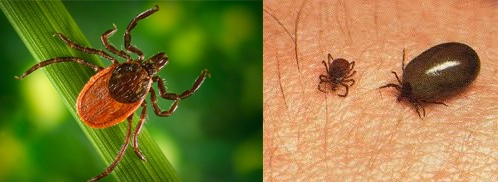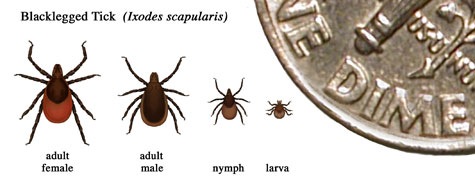
Lyme disease, also known as Lyme borreliosis, is a bacterial illness that can be transmitted to humans, dogs, and other animals by certain species of ticks. It is caused by the spiral-shaped bacterium Borrelia burgdorferi that is carried inside the tick and then gets into the dog’s or person’s bloodstream through a tick bite. Once in the bloodstream, the bacteria can travel to different parts of the body and cause problems in specific organs or locations, such as joints, as well as overall illness.

The ticks that carry Lyme disease are especially likely to be found in tall grasses, thick brush, marshes, and woods—waiting to grab onto your dog when he passes by. A tick can transmit the disease once it has been attached to the dog for 24 to 48 hours.
First named when a number of cases occurred in Lyme, Connecticut, in 1975, the disease can be hard to detect and can cause serious, ongoing health problems in both dogs and people.
Although Lyme disease can occur nearly anywhere in the U.S., infection risk is low in some regions and high in others. The areas of highest occurrence are the Northeast, the Upper Midwest, and the Pacific coast.

The primary carrier of Lyme disease is the blacklegged tick (Ixodes scapularis), also called the “deer tick” or “bear tick.” The tick acquires the Lyme disease bacterium when it feeds on an animal that has been infected, such as a mouse, deer, or other mammal, and then it transmits the bacterium to the next animal it feeds on. Image: CDC

The blacklegged tick’s three life stages, showing relative size. The nymph and adult stages can transmit Lyme disease. Image: CDC
Blacklegged ticks are the primary carriers of Lyme disease. The ticks' favorite habitats are wooded, brushy areas, marshes, and areas of tall grasses. They can especially be found in woods and areas adjacent to woods.
"Tick season" can include much of the year. The ticks can be present in every season but are most active from October through March. The adult ticks are not killed by frost and can become active whenever the temperature is above freezing.
The ticks don’t jump or fly; they can only crawl. They get onto their host by waiting at the tips of vegetation. When a dog or person brushes against the vegetation, the tick quickly grabs on and then crawls to find a place to bite.
An infected tick must be attached for 24 to 48 hours to transmit Lyme disease (and at least 12 to 24 hours to transmit anaplasmosis, another serious tick-borne disease).

Lyme disease is unfortunately a fairly common canine disease. Symptoms can include fever, reduced energy, and lameness.
Typical symptoms of Lyme disease in dogs include:
Symptoms can progress to kidney failure, which can be fatal. Serious cardiac and neurological effects can also occur.

Your veterinarian can perform blood tests to check your dog for Lyme disease and examine him for any possible symptoms.
There are two types of blood test that can indicate Lyme disease. One is an antibody test, which detects presence not of the bacterium but of specific antibodies that are formed in the dog’s body in reaction to the bacterium. A positive test result confirms that the dog was exposed to the bacterium.
However, dogs who have been recently infected might not yet have a high-enough level of antibodies present in their bloodstream to show up on the test. Likewise, dogs who have been infected for a long time might no longer have enough antibodies present to show a positive test result. So there can be “false negative” test results for dogs who do indeed have Lyme.
The second type of test is a polymerase chain reaction (PCR) test, a specific DNA test that confirms presence of the disease-causing bacterium itself. Again, false-negative test results can occur, however, as the bacteria might be present in an affected joint, for example, but not in the blood cells that were tested.
Treatment includes administration of an antibiotic, usually for several weeks. This often will quickly resolve symptoms, but in some cases infection will persist and prolonged medication may be needed. Treatment can also include other therapies aimed at resolving or relieving specific symptoms.
Dogs are not a direct source of infection for people. Lyme disease can’t be transmitted from one pet to another, nor from pets to humans, except through tick bites. However, a carrier tick could come into your house on your dog’s fur when he comes in from the yard or a romp in the woods, and then get on you.
If your dog is diagnosed with Lyme disease, you and any other pets have probably been in the same outdoor environment and may also be at risk, so it is a good idea to consult with your physician and veterinarian to see whether it might be appropriate to test other pets or members of the family.
People can do a number of things to avoid exposure to tick bites:
Ticks can also carry several other less common but serious bacterial diseases affecting dogs, including anaplasmosis and babesiosis.
Anaplasmosis can involve symptoms similar to those for Lyme disease. Babesiosis can present with a wide range of symptoms, from sudden and severe shock, high fever, and dark urine to a slowly progressing infection with more subtle clinical signs. Diagnosis of both diseases includes blood tests similar to those used to check for Lyme disease.
Sometimes dogs and people can become sick with “co-infection” of multiple tick-borne diseases, where more than one type of disease-causing bacteria is transmitted through a tick bite. This situation can make diagnosis and treatment even more challenging and difficult.

Wooded and brushy areas are especially high risk for the ticks that can carry Lyme disease. If you are in an area where Lyme disease is widespread, be sure to do a tick-check right away whenever your dog comes in from spending time in the woods.
A primary way to prevent Lyme disease is tick avoidance. Recommendations on preventing ticks on your pets include these from the CDC:
Many reliable products are available to prevent your dog from getting fleas and ticks. These can include oral medications as well as “spot on” or topical formulas that are applied directly to your pet’s skin. Not all preventives are the best choice for every pet, however, and some pets may have adverse reactions to a certain product. Be sure to talk with your vet about flea- or tick-control options, including any over-the-counter products, before using them on your dog or puppy. The American Veterinary Medical Association (AVMA) advises:
“Parasite protection is not ‘one-size-fits-all.’ Certain factors affect the type and dose of the product that can be used, including the age, species, breed, lifestyle, and health status of your pet, as well as any medications your pet is receiving. Caution is advised when considering flea/tick treatment of very young and very old pets. Use a flea comb on puppies and kittens that are too young for flea/tick products. Some products should not be used on very old pets. Some breeds are sensitive to certain ingredients that can make them extremely ill. Flea and tick preventives and some medications can interfere with each other, resulting in unwanted side effects, toxicities, or even ineffective doses. It’s important that your veterinarian is aware of all of your pet’s medications when considering the optimal flea and tick preventive for your pet.”
Sources: American Veterinary Medical Association (AVMA), U.S Centers for Disease Control and Prevention (CDC), Merck Veterinary Manual, VCA Animal Hospitals, and Companion Animal Parasite Council.

Learn about the most common canine diseases that are preventable with vaccines.
Get Free Download Now Natural Remedy for Dog Coughing
Natural Remedy for Dog Coughing
Natura
Natural Remedy for Dog Coughing
Natural Remedy for Dog Coughing
Natura
 Ten Things You Should Know About Your Puppy
Ten Things You Should Know About Your Puppy
Ten Things You Should Know About Your Puppy
Ten Things You Should Know About Your Puppy
 Average Lifespan of a Dog depends on Size
Large Dogs Seem to Age at a Fast Pa
Average Lifespan of a Dog depends on Size
Large Dogs Seem to Age at a Fast Pa
 What to Expect in the First Year After you Adopt a Puppy
What to Expect in the First Year After you Ad
What to Expect in the First Year After you Adopt a Puppy
What to Expect in the First Year After you Ad
 What Foods Can I Feed My Dog to Make Him Gain Weight?
What Foods Can I Feed My Dog to Make Him Gain
What Foods Can I Feed My Dog to Make Him Gain Weight?
What Foods Can I Feed My Dog to Make Him Gain
Copyright © 2005-2016 Pet Information All Rights Reserved
Contact us: www162date@outlook.com